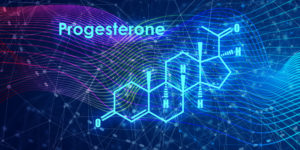
A LIFETIME OF PROGESTERONE
Written by Phyllis Bronson, Ph.D.
President,Biochemical Consulting and The Biochemical Research Foundation, Aspen, CO
https://phyllisbronsonphd.com/LifetimeofProgesterone.html
Progesterone is an essential element of a long and healthy life. The body’s need for progesterone spans an entire lifetime, from being essential for conception to offering disease prevention and other significant health benefits throughout all life stages.
In women, progesterone is secreted in the second half of the menstrual cycle (after ovulation) by the ovaries and, in much greater quantity, by the placenta during pregnancy. In both sexes, progesterone is also synthesized from cholesterol in the cortex of the adrenal gland, where it is a necessary precursor for the production of other hormones including testosterone, and it is also produced by cells in the nervous system.
Progesterone’s effects on a woman’s body are far-reaching and affect her entire lifetime. The role of progesterone spans all life stages, from the most basic prenatal needs, to menarche in puberty, during pregnancy and postpartum in the reproductive years, and throughout the transitional years of menopause.
Prenatal
 Immediately after a woman conceives, radical changes occur. For one, a new organ, the placenta, is formed in the womb. This is the hormonal pathway between a mother and her developing baby and is usually fully developed by about the fourth month of pregnancy. Once the placenta is formed, another radical change takes place-the placenta produces approximately forty times the woman’s normal amount of progesterone. Dr. Katharina Dalton explains that the morning sickness or vomiting typically experienced in those first few months “is a sign that the ovarian progesterone is insufficient and the placenta is not yet secreting enough progesterone.”
Immediately after a woman conceives, radical changes occur. For one, a new organ, the placenta, is formed in the womb. This is the hormonal pathway between a mother and her developing baby and is usually fully developed by about the fourth month of pregnancy. Once the placenta is formed, another radical change takes place-the placenta produces approximately forty times the woman’s normal amount of progesterone. Dr. Katharina Dalton explains that the morning sickness or vomiting typically experienced in those first few months “is a sign that the ovarian progesterone is insufficient and the placenta is not yet secreting enough progesterone.”
Progesterone is essential for maintaining a healthy pregnancy. A condition known as preeclampsia (or toxemia) is fairly common, occurring in about 5 percent of all pregnancies and, more frequently, in first pregnancies. Symptoms include a sharp rise in blood pressure, protein in the urine, and blood changes, all of which signal the potential for more serious problems to come for both mother and baby. Administering bioidentical progesterone to women with these symptoms significantly reduces the rate of preeclampsia. According to Dr. Alan Beer of the Chicago Medical School, progesterone “is necessary for the safe maintenance of pregnancy and all pregnancies will fail if progesterone production is too low.”
The children of women who supplement progesterone (but not with progestin; see Progesterone vs. Progestins on next page) during pregnancy tend to be advanced. In a study conducted by the City of London Maternity Hospital, the children of mothers who received progesterone during pregnancy stood and walked earlier, were above average in academic subjects such as verbal reasoning and arithmetic, and did better at school overall. In addition, a significantly higher percentage of those children continued on to college, when compared to the national average. The children of mothers who supplemented progesterone in the early months of pregnancy seemed to benefit the most.
At Birth
 Another sudden, radical change in progesterone occurs at the birth or delivery of the baby. Dr. Dalton explains that, at birth, “the placenta comes away from the womb, and suddenly, within twenty-four hours, the high level of progesterone in the mother’s blood drops to nearly zero.” At this point, the mother’s breasts begin to produce milk, stimulated by another hormone, prolactin, which also delays the menstrual cycle and the cyclic production of progesterone until after breastfeeding has stopped.
Another sudden, radical change in progesterone occurs at the birth or delivery of the baby. Dr. Dalton explains that, at birth, “the placenta comes away from the womb, and suddenly, within twenty-four hours, the high level of progesterone in the mother’s blood drops to nearly zero.” At this point, the mother’s breasts begin to produce milk, stimulated by another hormone, prolactin, which also delays the menstrual cycle and the cyclic production of progesterone until after breastfeeding has stopped.
After the euphoria of pregnancy and finally holding her baby in her arms, many mothers experience highly emotional days, with unexpected tears of emotion or even bouts of “the blues” as they adjust to their new life. However, about 10 percent of women experience a condition known as postpartum depression according to Dr. Dalton. Typical symptoms include high emotion and tearfulness plus anxiety, irritability, confusion and possibly even hallucinations, along with an inability to sleep. In severe cases, the mother may even reject or cause harm to the baby. Fortunately, postpartum depression, which is linked to a progesterone deficit, can be prevented by administering progesterone immediately after delivery. Supplementation may be continued as needed after that, including while breast feeding, according to Dr. Dalton. In fact, she adds, “progesterone enhances lactation, which is an additional bonus.”
Menarche
The first menstruation, also known as menarche, is an important milestone in any girl’s life and signals that she is about half-way through puberty. The first period of menstrual bleeding usually lasts about five days, but can vary between three and eight days.
Irregular menstrual patterns are quite common for young girls until they begin to ovulate, which generally occurs about two years after menarche.
Initially, ovulation may not occur every month, but about every two or three months, with the cycle becoming more regular over time. Progesterone is only released by the ovaries when ovulation occurs.
With the onset of ovulation, painful menstrual cycles with heavy or irregular bleeding may begin.
Sufficient levels of both progesterone and the estrogen hormones are needed to maintain a healthy, regular bleeding cycle. One of the estrogen hormones, estradiol, reaches its peak during the first half of the menstrual cycle, while progesterone peaks midcycle when ovulation has occurred. The timing of those peaks is one aspect of regulating the menstrual cycle.
Although, progesterone supplements can be used to reestablish regularity of the menstrual cycle, young women are frequently prescribed birth control pills to regulate their menstrual cycle.
Reproductive Years
 One of the primary decisions women must consider during their reproductive years is if and when they will have children. While there are many different forms of contraception, the one most often considered first is “the Pill,” which always contains progestin and usually includes one or more synthetic estrogens. Although there are no published clinical trials, Dr. Dalton discusses progesterone supplementation as an effective method of contraception, which may be helpful for women who do not tolerate the adverse effects of conventional birth control pills.
One of the primary decisions women must consider during their reproductive years is if and when they will have children. While there are many different forms of contraception, the one most often considered first is “the Pill,” which always contains progestin and usually includes one or more synthetic estrogens. Although there are no published clinical trials, Dr. Dalton discusses progesterone supplementation as an effective method of contraception, which may be helpful for women who do not tolerate the adverse effects of conventional birth control pills.
Many women are also prescribed birth control pills as an attempt to reduce symptoms of premenstrual syndrome (PMS), a hormonal condition primarily related to the timing of the spike of progesterone levels during the menstrual cycle. However, the progestin in these pills can actually cause PMS-like symptoms.
According to Dr. John Lee, PMS occurs when progesterone is low in relation to estrogen, and that additional progesterone is needed to balance the estrogen excess or “estrogen dominance.” Progesterone helps prevent erratic periods and heavy bleeding.
This concept is clearly demonstrated by the fact that PMS symptoms generally ease during pregnancy when high levels of placental progesterone are present, and recur almost immediately after pregnancy when a sudden loss of placental progesterone occurs.
Some practitioners believe that PMS does not occur in anovular cycles (that is, one without menstruation), so they recommend treatment by suppressing ovulation with birth control pills. Dr. Dalton promotes correcting the cause of the progesterone imbalance rather than subjecting women to the side effects of suppressed ovulation.
Polycystic ovary syndrome (PCOS) is another potential result of a hormone imbalance, whereby a woman’s menstrual cycle is dominated by increased androgen (i.e., testosterone) production and a lack of progesterone. In this situation, the ovary does not release the egg, no progesterone is produced, and the follicle could become a cyst. Dr. Lee notes that “If progesterone levels rise each month, as they are supposed to do, this maintains the normal synchronal pattern É and PCOS rarely, if ever, occurs.”
PCOS may start during adolescence, but is usually not detected until women are in their late 20s or 30s because it takes a long time for symptoms to develop. It is the most common cause of infertility in women today.
Bioidentical progesterone (not progestin) has been proven effective for inducing fertility when there appears to be some sort of ovulatory dysfunction. Evidence indicates that natural progesterone therapy poses no risk, may benefit those wishing to become pregnant, and may help maintain a pregnancy through the early months. Dr. Beer notes that women who have low levels of progesterone tend to suffer from infertility or miscarriages, and suggests that they “require progesterone supplementation to bring them into the safe levels.”
In fact, bioidentical progesterone has recently been heralded in the field of in vitro fertilization, where it is essential for successful implantation, and where progestin cannot be used. The progesterone used has exactly the same molecular formula as the natural progesterone produced by the body’s own placenta and ovaries, so there are no adverse effects.
Transitional Years
Irregular menstrual bleeding typically occurs at the beginning or end of a woman’s reproductive phase, when hormones are in a state of flux. During these life phases (i.e., puberty and perimenopause), irregular bleeding is usually caused by insufficient levels of progesterone and sometimes the estrogen hormones, resulting in no ovulation. The lack of ovulation means that there is no progesterone production during the second half of the menstrual cycle, resulting in irregular bleeding. Women who do not ovulate tend to have more irregular periods.
Progesterone provides an important estrogen-balancing anti-cancer effect. Progesterone (sometimes combined with estrogen hormones, depending on the diagnosis) helps prevent erratic periods and heavy bleeding. According to research conducted at the Mayo Clinic, progesterone therapy is effective in treating irregular bleeding, especially for women in perimenopause.
Dr. Susan Lark concurs that progesterone is “the most effective medical treatment available for women in menopause transition.”
In a study on the role of natural, bioidentical progesterone in maintaining “quality of life” in women at mid-life, Dr. Phyllis Bronson reported that anxiety was “more extreme during the luteal phase, or latter two weeks of the menstrual cycle. Even though objectively this is when there is a gradual natural increase in progesterone production. There is often too much estrogen to be mediated by the body’s available progesterone.” This progesterone deficiency contributed to “mid-life anxiety patterns” and the “changes in serum levels clearly correlated with the qualitative input” provided by the women. In other words, when progesterone and estrogen were in balance, the perception of quality of life improved and contributed to emotional well-being.
Researchers at the Mayo Clinic also examined quality of life between two subject groups, one of which received a progestin (medroxyprogesterone acetate), and the other received micronized bioidentical progesterone. The group receiving the bioidenticall progesterone reported significant improvements in their symptoms, including “vasomotor symptoms, somatic complaints, and anxiety and depressive symptoms.” The findings demonstrate significant differences in how progestins and bioidentical progesterone behave in the body, and how that behavior affects how women feel.
After the Reproductive Years
 After menopause, once the menstrual cycle stops, the ovaries no longer produce progesterone. However, the body still needs progesterone and does continue producing it in the adrenal glands and nerve cells.
After menopause, once the menstrual cycle stops, the ovaries no longer produce progesterone. However, the body still needs progesterone and does continue producing it in the adrenal glands and nerve cells.
The same is true for women who undergo a hysterectomy. Many healthcare practitioners prescribe only estrogen, with no progesterone, for a woman who has had a hysterectomy, with the mistaken belief that progesterone’s only role is protection against endometrial cancer. While she may no longer need that protection, her body still needs progesterone after a hysterectomy.
Speaking at a recent conference, Dr. Mitchell Fleisher stated that women who use estrogen supplementation should also use progesterone, whether or not they have a uterus. Estrogen promotes the overgrowth and enlargement of hormone-sensitive cells, and progesterone is essential to slow this proliferation and promote normal cell development. Thus, progesterone provides an important estrogen-balancing, anti-cancer effect.
Non-Reproductive Effects
Although it is considered primarily a “reproductive hormone” associated with menstrual cycles and pregnancy, progesterone provides benefits to all cells in the body, including those in the brain, heart, nerves, skin and bones.
Research indicates that “maternal progesterone” is at least partially responsible for gender differences in the human brain. Male and female brains have significant structural and neurobiological differences, including the number of progesterone receptors, which affects sensitivity to progesterone. These differences may be related to why progesterone has been a successful treatment for reducing seizures in some women, and why women’s brains tend to heal more easily after an injury.
Progesterone protects the brain against excitotoxins (substances that excite the brain cells to the point of death), including estrogen- induced “brain fog” and research is underway to understand progesterone’s potential for protection against Alzheimer’s disease. Together, estrogen and progesterone also directly affect the neurotransmitters that regulate mood, appetite, sleep, and pain perception.
Progesterone is also produced by cells in the body’s nervous system, where it helps form the protective layer around nerve endings known as the myelin sheath. The nervous system depends on the myelin sheath for insulation and for neurotransmission speed. Progesterone promotes myelin repair in both the central and peripheral nervous systems. Progesterone provides significant protection against cardiovascular disease by lowering high blood pressure, reducing arterial spasms, and inhibiting cholesterol buildup. These protective benefits are unique to bioidentical progesterone, not synthetic progestins. In fact, progestins actually increase the risk of coronary spasms and are now associated with an increased risk for cardiovascular disease.
Progesterone also offers protection against osteoporosis. Current research indicates that progesterone has (at least) a dual role in bone health: it stimulates osteoblast production, which results in new bone growth, and it interferes with glucocorticoids, which cause bone loss. Dr. Lee’s research demonstrates that progesterone not only prevents osteoporosis but, more importantly, can reverse it so that bones regain their normal bone mineral density.
Another significant benefit of progesterone is that it is antiproliferative, meaning it may offer protection against some forms of cancer, such as breast cancer. Breast tissue is highly sensitive to hormones, especially estrogen, which encourages breast cells to proliferate. Progesterone provides a counterbalance to that proliferation. Dr. Lee reports that the protective benefits of progesterone are clearly indicated by the results of a study in which “premenopausal women with low progesterone levels were found to have 5.4 times the risk of developing breast cancer, when compared to premenopausal women with normal progesterone levels.”
The Importance of Progesterone
 Progesterone’s contributions to a lifetime of overall health and well-being are numerous. In addition to the benefits mentioned above, progesterone is also necessary for balancing or facilitating many other hormones and nutrients, and it is a component of almost all other hormone activity in the body.
Progesterone’s contributions to a lifetime of overall health and well-being are numerous. In addition to the benefits mentioned above, progesterone is also necessary for balancing or facilitating many other hormones and nutrients, and it is a component of almost all other hormone activity in the body.
With such far-reaching repercussions, it seems obvious that the need for progesterone spans the entire lifetime, affecting all life stages, and that a chronic deficiency can lead to a wide range of health issues, including breast cancer, osteoporosis, and cardiovascular disease. Fortunately, a progesterone deficit can be treated.
Furthermore, a review of the literature reveals hundreds of studies where progesterone has been shown to have beneficial effects. For example, evidence suggests that it has “neuroprotective” characteristics that offer hope for treating neurodegenerative conditions such as multiple sclerosis and the lingering effects of stroke or head injury. In fact, an ongoing clinical trial offers promising therapeutic results when progesterone is administered shortly after a traumatic brain injury.
Please contact your healthcare practitioner or compounding pharmacist for more information about progesterone supplementation.
Progesterone vs. Progestins
The progesterone hormone and its synthetic analog, known collectively as progestins, are not the same molecular structure and, therefore, do not behave the same way in the body.
Progestins were developed because of a mistaken belief that bioidentical progesterone (i.e., progesterone that is biologically identical to that produced by the human body) could not be easily administered as an oral drug. Progestins are now the “basis of all contraceptive pills and gave rise to a multibillion-dollar industry,” according to Dr. Dalton.
When progestins were first developed researchers and practitioners believed that they were true progesterone substitutes. We now know that they have significant differences, including:
• Progesterone is essential for maintaining pregnancy, while the use of progestins during pregnancy is associated with fetal abnormalities.
• Progesterone lowers blood pressure and progestins raise it.
• Progesterone is converted by the adrenal glands into all the stress hormones, while progestins are not.
• Progesterone promotes calmness and progestins do not.
• Progesterone relieves water and sodium retention, whereas progestins attract and hold water. According to Dr. Phyllis Bronson, this primary difference explains why so many women on the Pill and other conventional progestin based hormones are prone to edema (water retention), which can result in “brain fog” or feeling bloated.
¯

